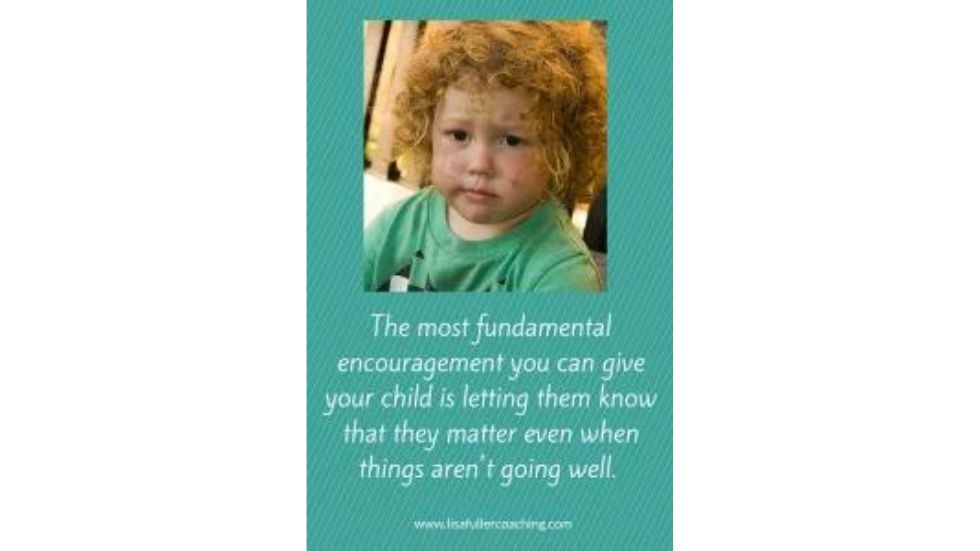
by Lisa Fuller | Jan 14, 2015 | Encouragement, Parenting, Self-regulation, Sibling Issues
During a parent education evening last week, I rattled on about the importance of encouragement in parenting and shared my favorite slogan, “Children Do Better When They FEEL Better.” Then an arm shot up.
One of the parents, Sarah, looked sincerely puzzled and asked a simple question that got every head in the room nodding:
“Encouragement and Positive Discipline are great when it’s a low stakes situation, but what about when safety is involved? How should I respond to a threat of physical harm from one of my children to the other in a positive way?”
When I asked her to explain her situation, Sarah told the following story (which may be very familiar to anyone with children close in age and remembers, or is going through, the baby/toddler sibling combination):
It was the end of the day, about an hour before my husband got home… typically my roughest time. Gus (3) was zipping around the house on his tricycle when he headed straight for his little brother (6 months), stopping just a hair from Fisher’s little fingers. I told him not to do that, that he could hurt Fisher and it didn’t feel safe to me. A minute later, he did the exact same thing and I basically flipped my lid. I yelled, “STOP,” stormed over to Gus, pried him from the tricycle, and let him cry on the ground as I put the trike outside. I felt really protective of Fisher and that I needed to stop Gus. I felt awful for yelling and reacting in a physical way because he was so sad afterwards. But how else could I show him that I was in charge?
Sarah’s story highlights the primal nature of being a parent. We’re hard-wired to protect our children from a perceived threat, even if that threat is their sibling. Keeping your children safe is your first priority as a parent and if a quick intervention — sometimes ungraceful or inflated — is urgently needed to protect a baby or younger sibling from harm, you need to do that, and quickly.
But I encouraged Sarah (as I would any parent) to turn from the immediate danger to look for connection and encouragement with the older child instead of punishment. I know this sounds crazy and counter intuitive but here’s what Positive Discipline teaches us:
The most fundamental encouragement you can give your child is letting him or her know they’re significant even when things are not going well.
(Significance here means has value, has meaning, matters to you and to the broader community, etc.)
What does encouragement look like in this situation? How can Sarah communicate that Gus has significance?
Sarah could physically block the trike from Fisher’s path (as it does not appear that Gus intended to stop on his own) and take a deep breath (essential in such a case).
Rather than lifting him off the trike right away, she could gently and firmly lift just Gus’ hands off the handlebars, look into his eyes and say:
Gus, wow, my he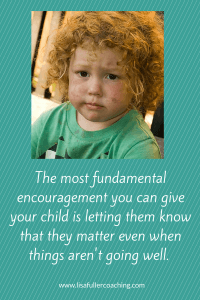 art is beating really fast because you really scared me by coming that close to Fisher’s hands. (Pause and breathe.) I could use a hug right now – could you give me a hug? Let’s bring your brother in, I bet we could all use a hug to feel better.
art is beating really fast because you really scared me by coming that close to Fisher’s hands. (Pause and breathe.) I could use a hug right now – could you give me a hug? Let’s bring your brother in, I bet we could all use a hug to feel better.
If this feels impossibly warm and fuzzy in such a potentially dangerous situation, consider this story from Gus’ point of view.
Rather than feel punished and sad (as he clearly did when the trike was chucked outside and he was left crying), Gus might think, “I did something wrong that really scared my mommy. What I do has an impact. I’m important to mommy and I can even help her feel better.”
The most fundamental encouragement you can give your child is letting them know that they have significance, even when they’re misbehaving.
In this scenario, asking for a hug is encouraging – very different than offering a hug because you’re engaging your child in being part of the resolution in an active way.
CHILDREN DO BETTER WHEN THEY FEEL BETTER! (we all do!)
Even when our children misbehave – if we can take steps to help them feel better, rather than making them feel worse, we are much more likely to encourage the kind of behavior we want to see from them in the future.
4 Steps for changing our response from punishment to encouragement:
- Shift your assumptions: Work on moving from my child will learn to behave by being punished to my child will learn to behave by getting the message that he or she matters.
For an example Sarah also shared a story of how she “felt a shift from the tricycle incident” just the day after my presentation. She wrote:
Gus was standing on his stool near the stove where I was getting ready to cook an egg. He tossed the hot pad that was on the counter onto the hot pan. I exclaimed surprise and got the pad out. I told him that was really scary and we absolutely do not throw things on the pan. He didn’t seem to be doing it out of defiance, which probably helped my reaction just be scared and then clear. But it was like we were scared together, learned something, and then moved on. No tears, no drama…so much better. It just gave me a taste of what you were talking about.
- Plan ahead: We’ve all yelled at and lost it with our kids, but by thinking through possible responses to common challenges ahead of time, we have a greater chance of pausing and consciously responding rather than giving our knee jerk reaction.
For example, I have a son who leaves what I call anonymous messes quite regularly around the house. This is a common challenge that I’ve planned ahead for by deciding on a few ways to respond when I’m next faced with his mess. Just yesterday, I found what looked like spilled detergent on the floor near the washing machine, covered with pillow cases. I suspected he left this mess and rather than simply accuse him and rant AT him for not taking the time to clean up, when I saw him I’d calmly asked a few clarifying questions, had he been doing laundry (yes), did he know about a spill, (why yes he did — this fessing up is progress), what could he do about it now? (This is a challenge for me but staying calm and building cooperation — progress, not perfection — is a huge victory for me and the only way I can do it is by planning for it).
- Assemble your parenting toolkit: Know your game plan by having tools at the front of your mind (Such as, “I need a hug,” asking WHAT & HOW questions like “what’s your idea to solve this problem?”). Sort through the Positive Discipline Tool Cards and pick three you’d like to try.
- Get support: Reach out for professional support. Even if it’s not with me, find someone who can help you weather the shift and put this new approach into action over time. It’s about progress — not perfection!
Regardless of the age of your child, encouragement through connection, in place of punishment is life changing — for both parent and child!
Please share in the comments below simple ways that you can remind your child of their significance (that they matter) today. In doing so, you’re giving us ideas that will encourage us to plan ahead – step 2 above! We’re all in this together 🙂
If you haven’t already done so, join me on this journey!
Wanna talk? Schedule a time here.
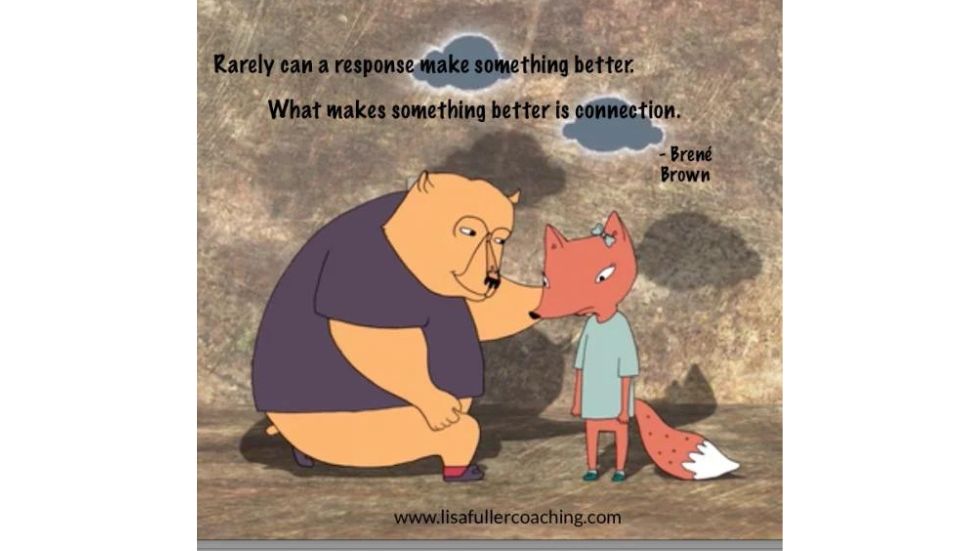
by Lisa Fuller | Dec 2, 2014 | Communication, General, Mutual Respect, Parenting, Self-regulation
In my last post, I shared how I missed an opportunity to practice empathy. Today’s story is the unexpected follow-up:
Songbird, my eight year old daughter, was at her cousin’s house. I texted my mom who was in charge, “When’s a good time for pick up?”
Mom texted back, “one hour.”
Five minutes later I receive another text, “Make that 30 minutes.” Then another message shot back “NOW.”
I head over to find Songbird curled up on the couch weeping – big sad boo hoo tears rolling down her cheeks. Mom starts to explain that cousin doesn’t want to share her new modeling clay – I hear a well-known refrain from across the room –
“It’s too special.”
Meanwhile, steady crying from Songbird.
Now comes the tongue biting as I work to keep these thoughts from tumbling out my mouth:
- It’s okay, you can put that on your Christmas list.
- I’m sure she’ll let you play with it, once she’s had it for a while.
- You’re really tired – it’s not a big deal. Now stop crying.
- Now don’t be that way Songbird, you know you can’t get everything you want.
Instead, having recently steeped myself in what empathy is and is not I wait, refrain from the above garden variety of knee jerk reactions.
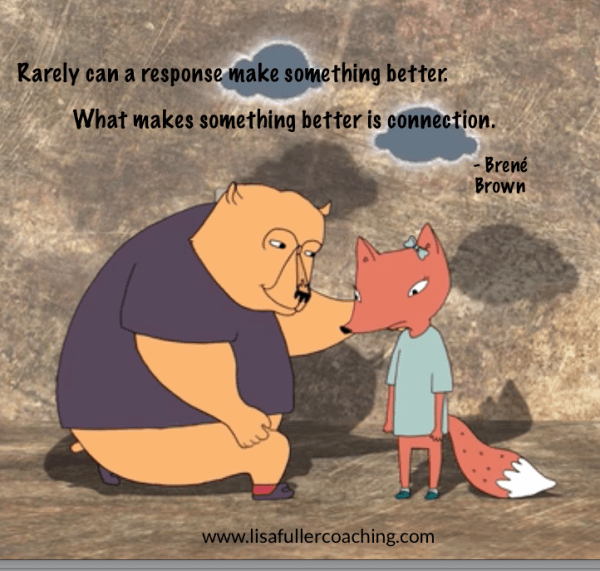 Then, consciously I say, you look sad.
Then, consciously I say, you look sad.
Songbird: Yes, I’m really sad!
Me: It seems like your heart hurts.
Songbird: Yes, (boo hooo) it hurts a lot.
Me: I’m sorry sweetie. Let’s say goodbye and go home.
Songbird: (Weep weep) Okay.
Wailing and sobbing continue as we head out to the car – they continue as we drive.
When we arrive home, 10 minutes later, Songbird gets out of the car, singing (makes sense), she skips her way to the door.
All of the usual responses we might use (those I listed above) diminish trust. When we use empathy — in this case, simply acknowledging and naming Songbird’s sadness — we build trust.
Expressing empathy in this situation was simple but not necessarily natural or easy – my bloody tongue is proof!
Simple, how? – all I did was genuinely acknowledge her emotion – naming it and finding a soft place in myself that has known that feeling too.
Not easy, how? I’ll put myself out there and say that although I’ve been teaching Positive Discipline classes for 10 years, empathy is a conscious practice, one that I only feel I’ve recently come to more fully understand.
So, today I’ve made a commitment to myself to practice deliberate empathy – and to expect I’ll make mistakes along the way. I’ll comeback around when I’ve missed the mark and attempt connection through empathy again and again.
According to the work of Theresa Wiseman and Kristin Neff, these five attributes of empathy are key. (You can see the animated video depicting these attributes, narrated by Brené Brown, by clicking the photo above.)
In this list, I’ve included examples of:
1. How I practiced this attribute in my story and
2. Common responses that act as barriers to empathy.
-
Staying out of judgment:
- Keeping my mouth closed about any internal evaluation I’m making as opposed to saying,
- “I don’t know why your cousin hasn’t learned how to share yet – at least you’re a good girl.”
-
Taking the other person’s perspective. What’s that experience like for you?
- “You look like your heart hurts.” instead of…
- “Why are you making it such a big deal? Buck up and move on!”
-
Understanding the emotion you’re hearing. How can I touch within myself something that feels like what my child may be feeling? Check in for clarity by asking questions.
- “You seem really sad.” as opposed to…
- “You really shouldn’t feel that way – you can put modeling clay on your Christmas list.”
-
Communicating our understanding about the emotion. (This seems like overkill for this example, but you might say…
- “Oh I know I feel sad when I don’t get to explore something I’m really curious about” as opposed to…
- Not understanding that emotion… “It’s really aggravating when people don’t share.”
-
Practicing mindfulness.: Rather than pushing away an emotion because it’s uncomfortable, feel it and move through it. If we get stuck in the emotion we don’t actually support the other person– boundaries are key to empathy.
- “Your heart really hurts.”
- “It’s very upsetting that your cousin won’t share with you. I’m pissed about it and will talk to her mom as soon as I can.”
Can you feel how the #2 responses edge out the space needed for empathy? Kids need a safe space to have their feelings so they can move through them and eventually let them go.
Thank you for joining me in exploring the complex nature of empathy.
The two big takeaways:
-
Empathy takes conscious awareness – it isn’t natural, especially with your loved one.
-
Empathy is not about perfection but rather a practice that you can come back to again and again – it takes being open to being vulnerable to do it.
Take a moment to share your empathy hit or miss in the comments below.
Wanna dig deep into empathy and other powerful tools? Contact me for one on one coaching!
If you haven’t already done so, join me on this journey!

by Lisa Fuller | Apr 29, 2014 | Connection & Love, Cooperation, General, Parenting, Self-regulation
You know those times when you’ve just got to get your child to do something important (go to the doctor, to swim class, the dentist…) and she/he refuses to cooperate? Then you think, “Why can’t they just get with the program this one time? Why does everything have to be so hard?”
Well, let me introduce Susan, mother of 9 year-old Alex, and a recent graduate of my 7-week parenting class. In this story, Susan shares the remarkable shift that happens when she uses tools she learned in the series. Without giving too much away, here are the two conversations (with very different outcomes) between Susan and Alex:
BEFORE taking Positive Discipline Class
Susan: “Hey Alex, Dad and I forgot to tell you – Swim lessons start today, so you need to get ready to go.”
Alex: (Playing with Legos) “What? I don’t want swim lessons! You know I hate lessons!”
Susan: “Alex, learning how to swim is really important – it’s about safety.”(Susan begins to feel angry and thinks, “What’s so hard about going to swim class? Swimming is great. This should be fun. Why is it so difficult?”)
Alex: “I don’t want to.”(He starts to crush his elaborate Lego creations). “I’m not going.”(He sits defiantly on the couch.)
Susan: “Swim lessons are a privilege, young man. That’s enough of your whining. Stop it. Now!”
Alex: “You never ask me what I want – I HATE YOU!”
Susan: (Thinking… “I hate this. I hate how hard it is to motivate my son. Forget it, I give up.”) She stomps off to another room to grab the swim gear.
Susan: “We paid for this class. Now get up and get to the car!”
Susan and Alex are both miserable and swim lesson does not go well.
Sound familiar?
AFTER taking Positive Discipline Class
Susan: (Taking some time beforehand to prepare herself.) “Hey Alex, Dad and I forgot to tell you but you’ve got swim lessons today. I’m really sorry that we’re springing this on you, but we gotta go now. I’ve got your swim gear and a snack for the car.”

“Both of these Positive Discipline Tool Cards were key. I feel I learned the most about the power of validating feelings!“
Alex: “What? I don’t want swim lessons! You know I hate lessons!”
Susan: “Honey, you only have to go four times and we found a new place where there are fewer kids so you’ll be able to hear better.” (She shows remorse for not giving him any warning and feels empathy for him, knowing that while he hates lessons, he actually loves to swim.)
Alex: “I don’t want to!” (He starts to crush his Lego creations.) “I’m not going.” (Alex plops himself defiantly on the couch.)
Susan: “Alex, sweetie, I know this is upsetting, but destroying your Legos is not OK. You can hit a pillow if you’re angry.” (She allows him to express his feelings. She calmly and firmly tells Alex that swim lessons are something he just needs to do. Susan uses only one or to sentences instead of lecturing him.)
(Alex violently hits the pillow. Susan leaves the room. Then she remembers that staying with him might feel encouraging to him. She goes back and keeps him company but doesn’t try to fix or change his feelings.)
Susan: (After some time has passed, speaking gently…) “Honey, it’s time to go.” (Alex gets up and together, they walked to the car. During the drive Susan felt connected to her son through their easy conversation and a palpable sense of calm. Alex even seemed to enjoy the lesson!)
This story’s a beautiful example of how empathy and encouragement go a long way toward winning genuine cooperation. Through her use of grounded positive energy and empathy Susan not only accomplished her goal of getting Alex to his swim lesson, she laid the groundwork for a foundation of trust.
Later she she told me,
It was a tiny miracle that I didn’t lose it and Alex was able to get up to walk to the car. It worked mostly because I didn’t flip my lid. Being there while he hit the pillow actually calmed me down too! Now Alex is doing great with his lessons. He still complains, but there is an ease and matter-of-factness about our interactions.
Thank you Susan for sharing your story!
If you’re curious about deepening your parenting practice and learning the art of cooperation through empathy, check out my one-on-one coaching opportunities and it you’re in the Bay Area, my fall Positive Discipline Series.
CONSIDER⇔SHARE⇔ACT
What gets in your way of just being with your child while they’re caught up in a feeling? Next time a big emotion hits, try bearing it with an attitude of love and let us know what happens!!

by Lisa Fuller | Feb 18, 2014 | Conflict, Discipline, General, Motivation, Power struggle, Self-regulation
Do you often feel CHALLENGED by your child? You’re not alone. If you’re like me, you’ve got a kid who will argue with or defy you at every turn. Can you say, “power struggle”?
Here’s the twist – I’ve grown to cherish this quality in my son, E. – he’s inspired me to teach Positive Discipline and grow in ways I never imagined.
Amen!
In my last post I wrote about a time when I lost it with him.
Today, I want to introduce a powerful tool that will give you concrete, helpful responses to your child’s misbehavior based on… drum roll please – how YOU feel.
The end result? A child who’ll more likely cooperate, contribute, and act like a leader in the best sense.
Here’s my before-and-after story to illustrate how using this tool, and identifying my feelings, gave me the opportunity to have an AFTER to write home about!
Before
I was cooking dinner one afternoon. My 12-year-old son was playing the piano in the other room. From the kitchen I could hear 8-year-old E.(enter our ‘hero’) join his brother at the piano and begin running his forearm up and down the keys, causing a cacophony.
My jaw clenched. I burst onto the scene and yelled at him, “WHAT ARE YOU DOING?! LEAVE YOUR BROTHER ALONE! GO UP TO YOUR ROOM RIGHT NOW!”
Not my most inspired parenting moment but one I think many parents can relate to.
Later, I asked myself these questions:
-
What did my son learn from this interaction? “Mom is crazy, Mom is mean,” etc.
-
Do we feel harmonious and connected? No. I’m angry. He’s likely feeling indignant, hurt or both.
Now’s my chance to use that tool I mentioned earlier.
Don’t let this chart intimidate you! I use it to give me an idea of how to respond based on HOW I FEEL when E. bangs on the piano. Yes, it sounds counter-intuitive, but observe how it WORKS….
In my noisy example I’m feeling CHALLENGED. Based on the chart (see second row – misguided power), my son believes “I count or belong only when I’m boss, in control, or proving no one can boss me.” This rings true to me… how about for you?
Here’s what happens when I use the suggestion in the final column.
After 
Piano cacophony starts: I say calmly, “E., I could use your help here in the kitchen. What do you think about using this sharp knife to chop these carrots for the soup?”
His eyes light up, and before I know it, we‘re working together, happily making dinner.
Giving E. work and/or responsibility is often right on the money when I start to feel provoked by him. This requires me to pause and have the presence of mind to respond rather than having my knee-jerk reaction.
Don’t try to memorize the chart. It’s simply a tool for guiding new responses based on how YOU feel when your child misbehaves. Hang it on your fridge or bathroom mirror so you can refer to it easily.
Positive Discipline isn’t about doing everything just right for your kids.
It’s more about the power of thinking ahead and the awareness that my child’s misbehavior is an opportunity to teach him what I value most – in this example: patience, creativity, and that the work it takes to create a yummy meal can be fun.
Utilize the chart and one day, when the scene is set for that familiar conflict, you’ll respond (instead of react), and out of the blue, experience the wonder of your child’s generous cooperation.
P.S. Carefully place a sharp knife into your toolkit and… magic!
CONSIDER⇔SHARE⇔ACT
Do you have an on-going dynamic with your child where you could see using this tool? How?
What’s the difference for you when you respond rather than react to your child or for that matter, anything in your life?
Share your thoughts below! It’s encouraging to know we’re not alone in this parenting journey!
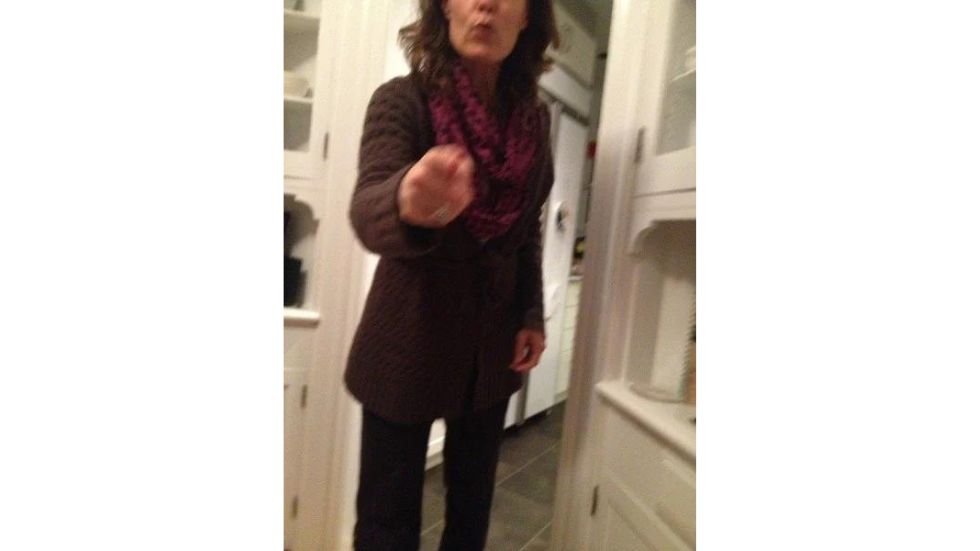
by Lisa Fuller | Feb 4, 2014 | Connection & Love, General, Parenting, Self-regulation
You know those moments when you are pushed to the brink, when you know that just one more movement or word from your sweet angel will push you to explode, to yell “I CAN’T TAKE IT ANYMORE!!!!” so loud it freaks out the neighbors?
If you’re like me, you also strive to maintain a sense of calm in the midst of the craziness of parenting. Yes, this is a worthy goal, but we’re only human!
Here’s a not-so-pretty story from my own life a few years back:
I was sitting down to supper one night with my kids (pre-iPod), when my ten year old son, E., for the second time that night, ignored my request to strap his portable CD player to his body. (For his occupational therapy, E. did therapeutic listening for a half hour each morning and evening.)
E. rose to get himself a glass of milk and the CD player slid precariously to the edge of the table.

Reenactment photo taken by 7 year-old S.
That’s when it happened. I completely lost it – full on, crazy-woman, raised-voice, heart-pumping LOST IT. I vigorously pointed my finger at him and yelled, “THAT’S IT! YOU NEED TO TAKE CARE OF THIS NOW BEFORE YOU DO ONE MORE THING. YOU ARE PUSHING ME! WHY DO YOU KEEP PUSHING ME?! TAKE CARE OF IT RIGHT NOW!”
We stood two feet apart, his eyes wide, me breathing fast. Honestly, I felt like strangling him.
Ghost like and calm, E. turned and floated out of the room to find the belt device. I returned to my seat – heart still pounding.
I took deep breaths to regain my composure. I felt the heat of embarrassment rise in my body as my oldest son sat quietly at my side. In a matter-of-fact voice, my three year-old daughter said, “That was too loud mommy – it hurt my ears.”
When E. returned, he looked at me – a twinkle in his eye – already he’d forgiven me. With effort he pressed his hands on either side of his mouth, to keep from laughing. I couldn’t help but smile as I said, “Thank you for taking care of it,” (my Positive Discipline know-how seeping back into my consciousness).
As these words came out of my mouth laughter bubbled out too. Soon, we were all roaring. Through his giggles, E. commented “I’ve never heard you be so loud!” The laughter was healing and reassuring, like we knew I’d just been possessed by Mommy Dearest and was now back to my usual self.
As we ate and laughed some more, I said I was sorry and expressed my regret. I could tell they were eager to move on. We felt close and connected.
Jane Nelson says, “Instead of feeling guilty when you make a mistake, rejoice that you have just provided a good example for your children.”
I wish I could rejoice but I’m not there… yet. When I make a mistake, I consciously keep the guilt to a dull roar so that I have the energy and bandwidth to be present and take the opportunity to connect. Now that’s something to rejoice about!
 I do lose it with my kids sometimes. Rather than brushing it under the rug, I try to do the following:
I do lose it with my kids sometimes. Rather than brushing it under the rug, I try to do the following:
- Acknowledge my mistake with my child in a timely manner so that it’s relevant to them.
- State a brief, simple sincere apology, “I’m sorry I lost my temper with you.” What’s critically important here is that I don’t add – “but if you’d gotten the CD holder like I’d asked you to…” – this turns my apology into punishment (more on that later).
- After some time has passed I work with my child (or myself) to come up with a plan so that the explosion will be less likely to happen next time.
- Finally, there’s an element of trust and letting go, of being the best role model I possibly can and, of acceptance that I am…exquisitely… imperfect.
CONSIDER⇔SHARE⇔ACT
Do you lose it with your kids? You’re not alone. In another post I’ll share a “losing it” redo – what I learned from my triggered response and how I was able to step back and use Positive Discipline tools to make a different choice the next time. Empowering!
Share your thoughts below! The parenting journey is so much more fun when we travel it together!
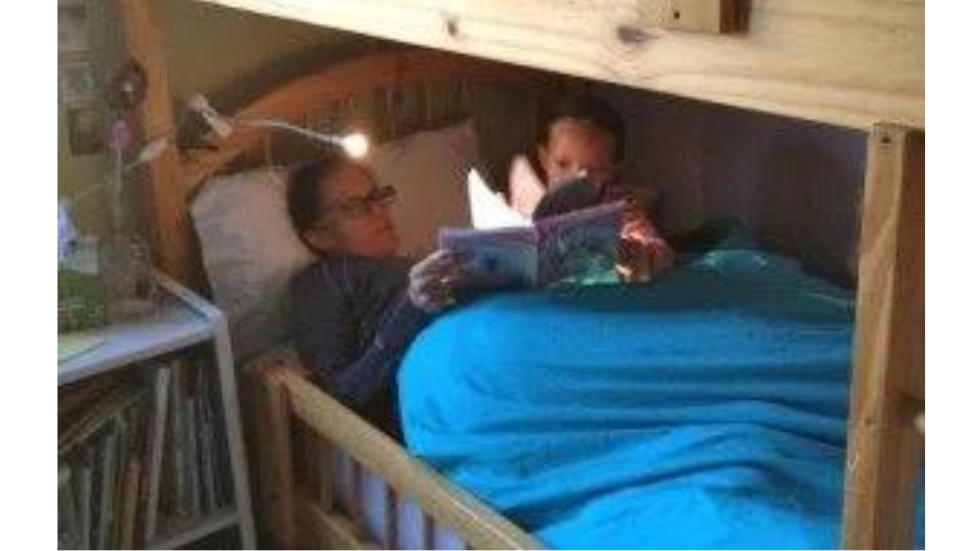
by Lisa Fuller | Oct 1, 2013 | Communication, Connection & Love, Feelings & Emotions, General, Parenting, Self-regulation
Wouldn’t it be great to have a “before” and “after” parenting show?
Last month I traveled on swanky Virgin America and enjoyed the guilty pleasure of watching “What Not to Wear”. Are you like me? Loving the transformation of the frumpy working gal into the self-confident put together chick? (Hint: I’m a great candidate – waiting to be nominated).
I’m drawn to the details of improvement – the way a crowded, gloomy living room, rearranged with better light, pillows, and plants becomes a welcoming space for activity and life. Powerful.
Let’s bring this analogy home to my life as a parent. Here’s a situation I’m sure you’ll relate to. Notice the before and after scenes – I’m the same, loving mom in each. The difference is, in the second scene, I have a deeper understanding of Positive Discipline and with a few tweaks, the interaction with my daughter is transformed at the core.

The scene: I’m putting my 6 year-old Sonja to bed and have just finished reading her a story.
Before:
Sonja: Mom, I’m afraid.
Me: What are you afraid of? (feeling a bit annoyed and thinking “what could you possibly be afraid of?!”)
Sonja: I’m scared to go to bed.
Me: There’s nothing to be scared of – you’re in your cozy bed and your family is home with you. (My annoyance is building.)
Sonja: I’m still afraid.
Me: That’s silly cause you are perfectly safe. (I’m determined to leave and stop this conversation.)
As I leave the room a jumble of thoughts go through my mind:
- What have I done to make her so insecure?
- What’s wrong with her that she can’t simply go to sleep?
- How will her fear manifest in the future?
- It’s simple, she hasn’t had enough hardship in her life – if she’d had more trials, like me, then she’d know what fear really is!
After (with a Positive Discipline approach):
Sonja: Mom, I’m afraid.
Me: What are you afraid of?
Sonja: I’m afraid to go to sleep. I’m afraid of all the normal stuff that people are afraid of.
Me: Where do you feel that in your body?
Sonja: My heart. It’s like I have butterflies fluttering in my heart and frogs jumping in my stomach.
Me: Oh, that doesn’t sound good. (I place my hand on her heart).
Sonja: Do you ever get scared?
Me: Yes. Remember last week when we were on the airplane and it was really bumpy and you were laughing and whooping it up? I was really afraid – I didn’t like how that felt AT ALL.
Sonja: I was scared too but it was also fun and funny.
Me: People get scared of different things – I LOVE GOING TO BED.
I left the room, my daughter fell asleep. I wasn’t worried about her future. I felt close and connected to her.
Let’s look at some of the obvious differences in how I felt and acted in the two scenes.
BEFORE:
- Worried
- Fearful
- Stuck in limited “role” of mom
- Focus on how I’ve failed as a mom
AFTER:
- Curious
- Open
- Interested in our shared human experience
- Willing to share my vulnerability
- In the present
- Faith in my daughter to figure it out
While there’s no perfect way to parent, we can make small, subtle shifts that bring in the light to reveal our higher self. When we allow this to happen, we truly sparkle. The end result? An intimate moment of precious connection with our child. There’s nothing more beautiful than that.
We have much to learn from each other.
CONSIDER⇔SHARE⇔ACT
In the comments below share what motivates you to go from scene 1 to 2? What helps you sparkle?
Next time you’re in that #1 scenario, stop, breath, connect, wait. Let us know what happens.
Contact me to learn more about parent and life coaching and future Parenting with Positive Discipline Classes.

 art is beating really fast because you really scared me by coming that close to Fisher’s hands. (Pause and breathe.) I could use a hug right now – could you give me a hug? Let’s bring your brother in, I bet we could all use a hug to feel better.
art is beating really fast because you really scared me by coming that close to Fisher’s hands. (Pause and breathe.) I could use a hug right now – could you give me a hug? Let’s bring your brother in, I bet we could all use a hug to feel better.












